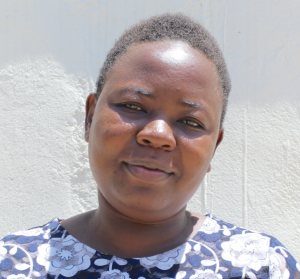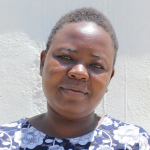Six years ago, the people of Shihome tried to protect their own spring to reduce the high numbers of water-related illness cases in their community. But without the necessary skills and knowledge, their efforts were in vain. Not only is the spring already falling apart, but the 280 people of Shihome are still suffering from illnesses that are both expensive to treat and debilitating to their health.
"Last month, my last-born son had been complaining about [a] headache," said 48-year-old farmer Dorcas Weyusia (pictured below fetching water). "I was forced to take him to the hospital, and after tests [were] done, he was diagnosed with typhoid, and a lot of money was spent."

The spring has a few problems that leave the water contaminated. First, the spring box (the area behind the discharge pipes where the water is filtered) is missing a fence that would prevent people and animals from inadvertently compacting the layers of clay, stone, tarp, and grass that protect the water. The spring's water should be captured at the source and funneled to the discharge pipe, but right now, the water is escaping the structure, seeping through the cement and past the discharge pipe.

"The workmanship was not good," said our field officer, Betty. "The water has diverted to an escape channel, leading to low discharge. To add on that, the catchment area is very dirty, which makes the water contaminated."
The low discharge that Betty described means that sometimes, especially during the dry seasons, water will only dribble out of the pipes. This creates problems for everyone at peak collection times when everyone needs water.
"It's my normal routine after school," said 16-year-old Oscar M (shown below). "I need to go and fetch water from the spring. Upon reaching there, the spring is always full, and many times [the] people whom I [see] there are older than me. I am forced to wait [for] them to fetch water first, but it really costs my time."

Because acquiring water takes such a long time, people get less of it. Without water to do essential daily tasks, people’s normal routines are disrupted, and important things like working and going to school are challenging.
"There is this one incident when I had a lot of schoolwork, and I had to get water first," Oscar continued. "By the time I arrived home, there was no power throughout the night, and I was supposed to submit the assignment [online]. I had to request my mother to escort me to school so that she could explain what happened to my class teacher. My mother refused. I was given [a] punishment the whole day, for I did not attend any lessons. From that day, I confirm the number of people at the water before I get my water container so that I can take the shortest time possible."
"[The] protection of the spring will reduce [the] water contamination at the spring, and the community members will be trained on spring maintenance and management," Betty said. "By so doing, all routes of contamination will be blocked, the catchment area will be clean, and water users will enjoy safe, clean drinking water."
What We Can Do:
Spring Protection
Protecting the spring will help provide access to cleaner and safer water and reduce the time people have to spend to fetch it. Construction will keep surface runoff and other contaminants out of the water. With the community’s high involvement in the process, there should be a good sense of responsibility and ownership for the new clean water source.
Fetching water is a task predominantly carried out by women and young girls. Protecting the spring and offering training and support will, therefore, help empower the female members of the community by freeing up more of their time and energy to engage and invest in income-generating activities and their education.
Training on Health, Hygiene and More
To hold training, we work closely with both community leaders and the local government. We ask community leaders to invite a select yet representative group of people to attend training who will then act as ambassadors to the rest of the community to share what they learn.
The training will focus on improved hygiene, health, and sanitation habits in this community. With the community’s input, we will identify key leverage points where they can alter their practices at the personal, household, and community levels to affect change. This training will help to ensure participants have the knowledge they need about healthy practices and their importance to make the most of their water point as soon as water is flowing.
Our team of facilitators will use a variety of methods to train community members. Some of these methods include participatory hygiene and sanitation transformation, asset-based community development, group discussions, handouts, and demonstrations at the spring.
One of the most important issues we plan to cover is the handling, storage, and treatment of water. Having a clean water source will be extremely helpful, but it is useless if water gets contaminated by the time it is consumed. We and the community strongly believe that all of these components will work together to improve living standards here, which will help to unlock the potential for these community members to live better, healthier lives.
We will then conduct a small series of follow-up trainings before transitioning to our regularly scheduled support visits throughout the year.
Training will result in the formation of a water user committee, elected by their peers, that will oversee the operations and maintenance of the spring. The committee will enforce proper behavior around the spring and delegate tasks that will help preserve the site, such as building a fence and digging proper drainage channels. The fence will keep out destructive animals and unwanted waste, and the drainage will keep the area’s mosquito population at a minimum.

 Protected Spring
Protected Spring
 Rehabilitation Project
Rehabilitation Project




































